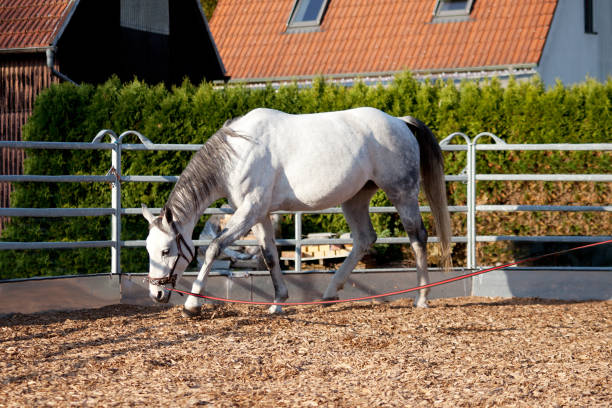Lunging a horse means it circles around you on the end a line. Horse and handler can both benefit from lunging. This is a great way to allow your horse to safely burn extra energy, and it can also help with teaching obedience.
Correctly done, lunging can improve flexibility and balance in horses. It can also help them get fitter if they have been not working. It can also be used to examine a horse’s gaits and determine if it has lameness. Lunging can also be used to teach skills to a rider without the need to control the horse.
Get Ready
Make sure you have all the necessary equipment before you attempt to lunge your horse. It is important to have a lunge line that measures between 30 and 35 feet in length. Flat webbing is better than rope, as it’s easier to manage and lighter. A lunge whip, halter or lunging cavesson are also needed (some people find cavessons too cumbersome). Horses can be protected by using wraps or boots for exercise.
You will also want to lunge your horse inside a ring, arena or round pen. When you are just beginning, it is important to avoid distractions.
It is also a good idea to have some gear for yourself. You will not trip or slide if you have sturdy boots or shoes. Gloves are a good idea to keep your horse from pulling too hard. Your voice will be your primary aid in cueing your horse.
Halte the horse
A sturdy halter or a lunging cavesson are required to allow your horse to lunge. Although a cavesson is not necessary, many horses can be trained to lunge with one. You should not use the hackamore or bit lunge line to lunge.
Get in the Ring
Take your horse to an arena or ring. Walk your horse around the circle that you would like it to use.
Keep the Whip and Lunge Line in Place
Your horse should be working to your left. To do this, hold your lunge line in your left and your lunge whip with your right. If your horse is moving in a circle to your right, hold the lunge line in your right hand and your whip in your left.
The whip and line should be held so that they form a triangle. You are the tip of the triangle. Your horse will be at the base of the triangle. Your elbows should be bent and your shoulders should be relaxed.
Walk the Horse
Ask your horse to “walk.” Ask your horse to “walk.” The majority of people use a slow, drawn-out for halt, and sharp, energetic words for walk and trot and canter.
Keep the circle going
You will keep the horse in the circle by keeping the line straight and not dragging the ground. Keep your elbows bent, the whip pointed at the horse’s heels. Keep the triangle.
Keep your circle small if you are moving at all. It is possible to get dizzy if you just keep spinning in one place.
Transitions from Upward to Downward
The whip can be used to reinforce your voice aid for upward movements–walk, trot, canter or trot to canter. Some horses can be handled with a simple wave of the whip. Others may require the whip to pop the lash. You can do this by flicking the whip hard. This will take some practice before you attempt lunging.
Many people lower the whip to the ground for downward transitions, such as trot to halt, walk to stop, walk to halt or canter to walk. The whip never touches the horse.
Stop the Horse
If you ask your horse for it to stop, it should remain on the circle and wait until you approach. Some people prefer their horse to come to them when they call. Do this by extending your lunge so that it doesn’t drag as the horse approaches.
Stop and change direction
Ask your horse for a change of direction. Tell it to stop, move backwards, then turn. Next, change your whip and line your hands to send the horse in the opposite direction. It will take time to get used to the movements and for your horse to be able to understand what you’re asking. You will soon be able to move your horse in one fluid motion, at a walk or trot, and not need to ask him to stop.
Problems and proofing behaviors
People often lunge their horses to get energy and exercise. You should not make your horse feel any less fit than you do. This will make it take longer for your horse’s leveling out to occur.
Lunging doesn’t mean letting your horse run around circles or firing in a circle. Either of these actions can cause injury and poor obedience. Horses should be just as willing to follow a leader when they are led on the lunge line. Lunging should not only be a physical activity, but also a mental one.
Lunging is not a form of punishment . A horse who acts out is not a good idea, and it’s never a good idea to punish them. Instead, build a relationship with your horse and teach them to trust you. This can be done by luddling.
The circle must be larger for horses that are moving faster than you. This can be achieved by letting out more lines. You can do this by letting out more line. Horses that are used to circling in a tight circle can have a hard time walking.

